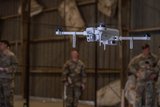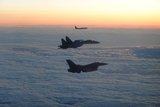Trump's nuclear policy may spark arms race
The US DoD is set to unveil US president Donald Trump's nuclear policy next week, and critics are already warning it could trigger another arms race and raise the risk of miscalculations that might spark an atomic conflict.
A leaked draft version of the Nuclear Posture Review indicates the US DoD is calling for the development of a new type of low-yield nuclear bomb that is designed to be used on the battlefield, rather than to level a city.
These so-called tactical nuclear weapons have a limited explosive strength – though still are staggeringly powerful compared to conventional weapons.
Underpinning the Trump nuclear doctrine is the concern that the country's weapons are so powerful that adversaries do not believe they would ever be used.
The draft policy says Russia's own low-yield nuclear weapons, within easy striking distance of Europe, provide ‘a coercive advantage in crises and at lower levels of conflict. Correcting this mistaken Russian perception is a strategic imperative’ the document stated.
Any weapon with an explosive blast of 20 kiloton or less is considered low-yield.
To put that in perspective, one kiloton is the same as 1,000t of TNT; the bombs dropped on Hiroshima and Nagasaki at the end of World War II were about 15 and 20 kilotons respectively, so they would be considered low-yield today.
However, the US already has a massive nuclear arsenal at its disposal, including 150 B-61 nukes stored across multiple European countries that can be configured for low-yield options.
Hans Kristensen, director of the nuclear information project at the Federation of American Scientists, said US military strategy does not need a new type of weapon.
Kristensen said: ‘If you really wanted to use weapons in a limited low-yield scenario, they are there. You do not have to have another one.’
Given the state of Russia's military forces and the country's financial problems, Moscow fears it would be quickly outmatched in a conventional conflict with the West.
To compensate, Moscow has an ‘escalate to de-escalate’ strategy in which it would deploy lower-yield bombs as part of a limited first use of nuclear weapons.
The US DoD's nuclear policy draft, which euphemistically calls low-yield bombs ‘supplements’, states that increasing such weapons would help deter Russia and other nations.
The policy states: ‘These supplements will enhance deterrence by denying potential adversaries any mistaken confidence that limited nuclear employment can provide a useful advantage over the US and its allies.’
Kristensen said he could envision a scenario where a US President was ‘less self-deterred’ from using a nuclear weapon if he thought it would only have limited effects on a civilian population.
The proposed policy says the DoD and the National Nuclear Security Administration will develop a low-yield submarine-launched ballistic missile for deployment and in the longer term, develop a sea-launched cruise missile.
The US currently has an estimated arsenal of about 7,000 nuclear warheads, second only to Russia, which has a few 100 more. The new missile types would not add to the stockpile but rather would reconfigure existing warheads.
Critics, including Democratic lawmakers, worry not just about developing new weapons but of the cost of overhauling the US's nuclear arsenal. Already, the price tag is more than $1 trillion over 30 years.
Congressman Adam Smith, the top Democrat on the House Armed Services Committee that oversees the US DoD, blasted the new policy.
Smith said: ‘The administration's recommendations will not increase our security. They will instead feed a nuclear arms race, undermine strategic stability by lowering the threshold for nuclear use, and increase the risk of miscalculation that could precipitate a nuclear war.’
Matthew Costlow, a defence analyst at the National Institute for Public Policy, said fears are being overblown.
Costlow added: ‘The nuclear order is not so fragile as to be shaken by the modification of a few warheads by a responsible nuclear power such as the US. In fact, there is evidence it could reduce the chances of nuclear war by making aggressive nuclear states like Russia and North Korea think more than twice about escalating a failing conflict.’
The new conversation marks a significant departure from the talking points of the administration of Barack Obama, who during a famous speech in Prague in 2009 called for the elimination of nuclear weapons.
In 2010, Obama and Russia's then-president Dmitry Medvedev signed the so-called New START treaty that calls for a significant reduction in the nuclear arsenals of both countries.
That deal expires in 2021, when Trump could potentially be serving a second term.
Barry Blechman, co-founder of the Stimson Center, a nonpartisan anti-nuclear proliferation think tank in Washington, said he was worried some of the language in the draft nuclear policy would make it harder to renew that treaty.
Blechman said: ‘I am very concerned. It is a step toward this direction of fighting nuclear wars as a realistic option.’
More from Defence Notes
-
![Elbit Systems awarded $2.3 billion contract as results soar]()
Elbit Systems awarded $2.3 billion contract as results soar
The company’s order backlog as of 30 September totalled $25.2 billion and more than a third of this is scheduled to be fulfilled before the end of 2026.
-
![US military foresees growing use of 3D printing]()
US military foresees growing use of 3D printing
Advanced manufacturing has evolved to meet military requirements and now supports multiple US critical assets, including Arleigh Burke-class destroyers, F-18, F-22, F-35, Bradley, HMMWV and Patriot.
-
![Irish Naval Service expands as the country looks to defence during EU presidency]()
Irish Naval Service expands as the country looks to defence during EU presidency
The Irish Naval Service has struggled to maintain capability, particularly in the face of lucrative private sector offers luring away personnel.
-
![Resilience, adaptiveness and collaboration vital for success in space (Studio)]()
Resilience, adaptiveness and collaboration vital for success in space (Studio)
Speakers at the Defence In Space Conference (DISC) 2025 highlighted the critical and evolving role of space in national security, defence and the global economy.
-
![Why the NORAD inventory might be the US and Canada’s Achilles’ heel]()
Why the NORAD inventory might be the US and Canada’s Achilles’ heel
Both the US and Canada operate Cold War-era capabilities which cannot defeat today’s and tomorrow’s threats.

























